The double hung windows market is projected to expand from USD 5.5 billion in 2025 to USD 7.6 billion by 2035, at a compound annual growth rate (CAGR) of 3.3%. Between 2025 and 2030, the value is expected to grow gradually from USD 5.5 billion to USD 6.4 billion, indicating a measured upward curve. The growth curve for this market is shaped by consistent demand in residential and commercial construction projects, where double hung windows are valued for their design flexibility, ease of maintenance, and aesthetic appeal.
The steady adoption is supported by their practical ventilation features and compatibility with diverse architectural designs, making them an attractive choice for both new builds and renovations. From 2030 to 2035, the market is expected to advance from USD 6.4 billion to USD 7.6 billion, maintaining its smooth growth trajectory without sharp surges or declines. This reflects a stable yet incremental demand curve shaped by long-term replacement needs and a growing inclination towards durable building components. Double hung windows are increasingly being integrated into renovation projects as consumers prioritize functionality alongside style. The moderate expansion suggests that while the market is not expected to experience rapid jumps, it will sustain continuous growth driven by reliability, consumer preference for versatility, and consistent usage in both urban and suburban construction projects. The shape of this growth curve indicates resilience and reliability for manufacturers and stakeholders.
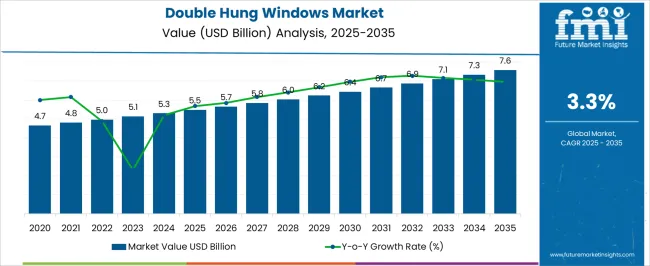
| Metric | Value |
|---|---|
| Double Hung Windows Market Estimated Value in (2025 E) | USD 5.5 billion |
| Double Hung Windows Market Forecast Value in (2035 F) | USD 7.6 billion |
| Forecast CAGR (2025 to 2035) | 3.3% |
The double hung windows market occupies a specialized segment within several broader parent markets, reflecting its unique positioning and adoption across both residential and commercial projects. Within the residential windows market, double hung windows account for approximately 25% of the total share, supported by their traditional appeal and ease of maintenance, making them popular in single-family homes and multi-unit housing projects.
In the commercial windows market, these windows hold around 10% of the market, as their design is applied selectively in offices and public buildings where both aesthetics and ventilation control are desired. Within the architectural building products market, double hung windows contribute about 8% of the total share, representing their integration into broader building design and construction materials. In the fenestration systems market, which encompasses all window and door types, double hung windows capture roughly 12% of the segment, highlighting their relevance in energy-efficient and design-conscious construction projects.
In the home improvement and renovation market, double hung windows account for approximately 15% of the market, reflecting their widespread use in remodeling and replacement projects.
The ability of double-hung windows to offer versatile ventilation control, improved insulation, and enhanced security features has positioned them as a preferred choice in both new construction and renovation projects.
The market is further driven by advancements in manufacturing techniques, enabling improved durability and design flexibility to match diverse architectural styles. Regulatory emphasis on energy efficiency standards and green building certifications has reinforced the adoption of high-performance window systems.
Additionally, the shift toward sustainable construction materials and the rising trend of home improvement spending are contributing to market expansion. With innovations in glazing technologies, weatherproofing, and frame materials, double-hung windows are expected to maintain strong demand, ensuring long-term growth potential across urban and suburban markets.
The double hung windows market is segmented by type, window material, frame material, application, end use, distribution channel, and geographic regions. By type, the double hung windows market is divided into traditional double-hung windows and tilt-in double-hung windows. In terms of window material, the double hung windows market is classified into Vinyl, Wood, Fiberglass, and Others. Based on frame material, the double hung windows market is segmented into UPVC, Glass, Aluminium, and Others.
By application, the double hung windows market is segmented into Residential, Commercial, and Industrial. By end use, the double hung windows market is segmented into Renovation and replacement and New construction. By distribution channel, the double hung windows market is segmented into Indirect and Direct. Regionally, the double hung windows industry is classified into North America, Latin America, Western Europe, Eastern Europe, Balkan & Baltic Countries, Russia & Belarus, Central Asia, East Asia, South Asia & Pacific, and the Middle East & Africa.
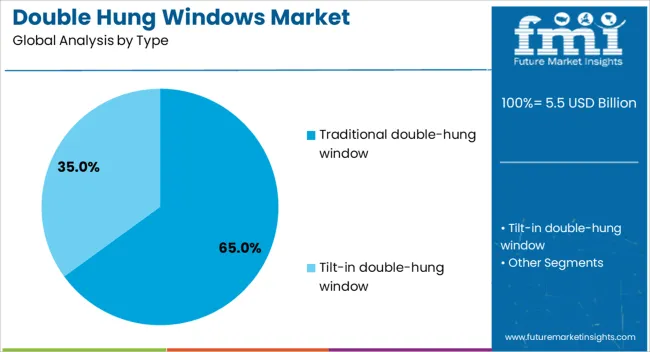
The traditional double-hung window type is projected to hold 65% of the double-hung windows market revenue share in 2025, making it the leading product category. This dominance has been supported by its timeless design, functional versatility, and ease of maintenance, which appeal to a wide range of homeowners and builders. The segment benefits from its adaptability to both classic and modern architectural designs, ensuring broad market acceptance.
Enhanced thermal performance, improved sealing mechanisms, and the integration of modern materials have strengthened its position in energy-efficient construction. The ability to allow ventilation from both the top and bottom sashes has also contributed to its popularity, especially in regions with varying seasonal climates.
Additionally, the long service life and compatibility with diverse glazing and frame options have reinforced its continued preference in both new-build and renovation projects. With growing consumer interest in durable, cost-effective, and visually appealing window solutions, the traditional double-hung window segment is expected to maintain its market leadership.
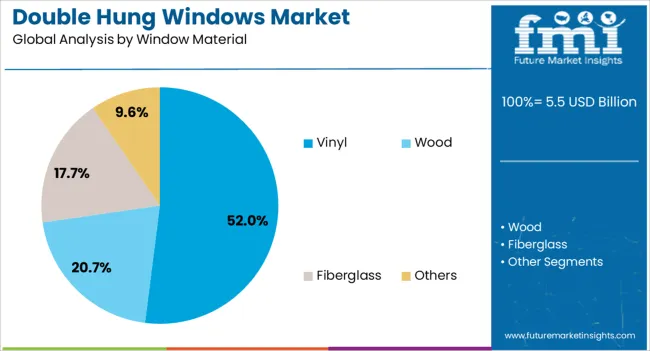
The vinyl window material segment is anticipated to account for 52% of the double-hung windows market revenue share in 2025, making it the most widely adopted material type. This growth has been driven by the material’s cost-effectiveness, low maintenance requirements, and strong resistance to moisture and environmental wear. Vinyl frames offer superior insulation properties, contributing to better energy efficiency and reduced utility costs for end users.
The ease of manufacturing and customisation has enabled a wide range of design options, meeting diverse consumer preferences. Additionally, advancements in vinyl formulation have improved its durability, color retention, and resistance to warping, ensuring long-term performance in different climate conditions.
Its lightweight nature simplifies installation, reducing labor costs and project timelines. The combination of performance, affordability, and aesthetic versatility has positioned vinyl as the preferred choice among homeowners and developers, ensuring its continued dominance in the market.
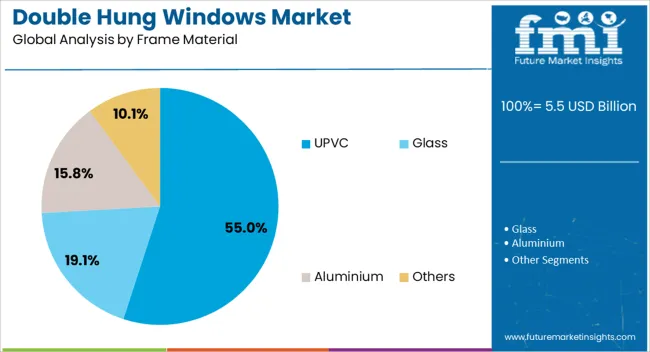
The UPVC frame material segment is projected to hold 55% of the double-hung windows market revenue share in 2025, solidifying its role as the leading frame type. This leadership is attributed to the material’s exceptional durability, energy efficiency, and minimal maintenance requirements. UPVC frames provide excellent thermal insulation, aiding in the reduction of heating and cooling costs while meeting stringent energy regulations.
Their resistance to corrosion, rot, and fading ensures long-lasting performance, even in harsh environmental conditions. The material’s inherent strength supports larger window designs without compromising structural integrity. Additionally, UPVC is a sustainable choice, being recyclable and contributing to eco-friendly construction practices.
Advances in manufacturing have allowed for a variety of colors and finishes, broadening its appeal to architects and homeowners seeking both performance and design flexibility. The segment’s ability to combine long-term cost savings, environmental benefits, and design adaptability is expected to sustain its market-leading position.
Residential and commercial construction projects offer significant opportunities, particularly in regions emphasizing building performance and comfort. Trends like customizable finishes, noise reduction, and enhanced durability are shaping product offerings. Challenges such as high costs and competition from alternative window types remain, but manufacturers who innovate and provide value-driven solutions are likely to expand their market presence steadily.
The double hung windows market is witnessing growing demand as homeowners and commercial builders seek energy-efficient window solutions. These windows, known for their dual-sash design, allow improved ventilation and enhanced thermal insulation, contributing to reduced heating and cooling costs. Renovation projects in residential properties are increasingly integrating double hung windows to improve aesthetic appeal and indoor comfort. The combination of ease of maintenance, durability, and flexibility in design is fueling adoption. As building regulations and energy codes become stricter, demand for high-performance double hung windows is expected to grow steadily.
Residential and commercial construction projects present significant opportunities for double hung window manufacturers. Growing investments in new housing developments, refurbishments, and commercial complexes are creating a continuous requirement for durable and visually appealing window solutions. Markets in North America and Europe show particular promise, driven by consumer preference for windows that balance functionality with style. Modular construction methods and prefabricated units also favor the inclusion of double hung windows due to their ease of installation. Companies that can provide customizable and cost-effective solutions are well-positioned to capture new contracts in both urban and suburban development projects.
Several trends are influencing the double hung windows market, including the integration of modern materials such as composite frames and laminated glass for enhanced durability. Consumers are increasingly prioritizing low-maintenance designs and noise-reduction features. Smart window solutions with sensor-based controls for ventilation and temperature regulation are gradually entering the market, responding to evolving consumer expectations. Color finishes, hardware upgrades, and decorative grilles are gaining popularity, reflecting a trend toward personalization. These factors are reshaping the market, with manufacturers emphasizing product differentiation to attract discerning buyers seeking both performance and visual appeal.
Despite growth potential, the double hung windows market faces challenges, particularly regarding high material and installation costs. Premium frames and specialized glass can make products expensive, limiting adoption in price-sensitive segments. Maintenance of hardware and balancing mechanisms also poses a concern in older installations. Competition from alternative window designs, such as casement and sliding windows, further adds pressure on market participants. Fluctuations in raw material costs and supply chain disruptions may influence production and delivery schedules. Addressing affordability and educating consumers about the long-term benefits of double hung windows is critical for expanding adoption.
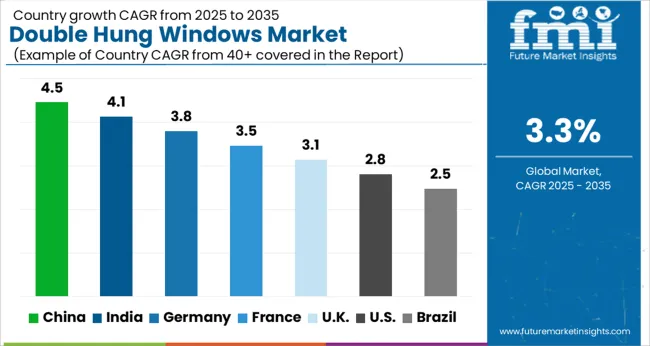
| Country | CAGR |
|---|---|
| China | 4.5% |
| India | 4.1% |
| Germany | 3.8% |
| France | 3.5% |
| UK | 3.1% |
| USA | 2.8% |
| Brazil | 2.5% |
The global double hung windows market is projected to grow at a CAGR of 3.3% from 2025 to 2035. China leads with a growth rate of 4.5%, followed by India at 4.1%, and Germany at 3.8%. The United Kingdom records a growth rate of 3.1%, while the United States shows the slowest growth at 2.8%. Increasing demand for energy-efficient and aesthetically appealing window solutions in residential and commercial buildings is driving growth. Emerging markets like China and India are experiencing higher adoption due to urban expansion, rising disposable incomes, and modern construction trends, while mature markets like the USA and UK focus on renovation projects, premium-quality windows, and compliance with energy codes. This report includes insights on 40+ countries; the top markets are shown here for reference.
The double hung windows market in China is projected to grow at a CAGR of 4.5%. Rapid urbanization, expanding residential and commercial construction, and increasing focus on energy-efficient building solutions are key growth drivers. Consumers and developers are increasingly opting for double hung windows for improved ventilation, thermal insulation, and aesthetic appeal. Additionally, government regulations promoting energy efficiency and green building standards are further accelerating market adoption.
The double hung windows market in India is expected to grow at a CAGR of 4.1%. Increased residential construction, modernization of commercial spaces, and rising disposable incomes are driving demand. The growing awareness of energy efficiency and thermal insulation benefits encourages the adoption of double hung windows. Furthermore, rapid urbanization and the expansion of tier-1 and tier-2 cities are contributing to higher installation rates, making India one of the faster-growing markets for double hung windows.
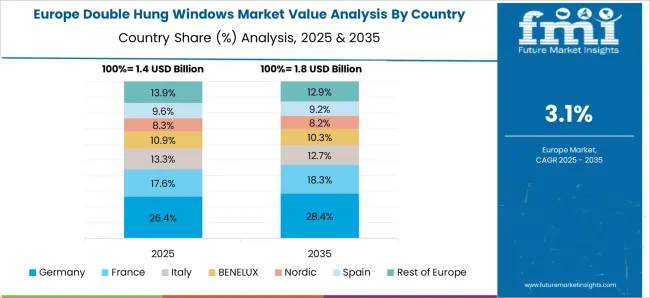
The double hung windows market in Germany is projected to grow at a CAGR of 3.8%. Germany’s strict building codes, energy efficiency standards, and emphasis on high-quality construction materials are key growth drivers. Demand is primarily fueled by residential renovation projects and commercial developments focused on improving thermal insulation and energy performance. The market also benefits from increasing awareness of durable and low-maintenance window solutions, which align with consumer preferences for long-lasting and efficient products.
The double hung windows market in the UK is projected to grow at a CAGR of 3.1%. Demand is being driven by residential and commercial renovation projects aimed at improving energy efficiency and property aesthetics. The UK’s regulatory framework promoting energy-efficient buildings also supports adoption. Additionally, consumer preference for premium-quality materials and improved ventilation in homes and offices continues to stimulate market growth, despite slower overall expansion compared to emerging regions.
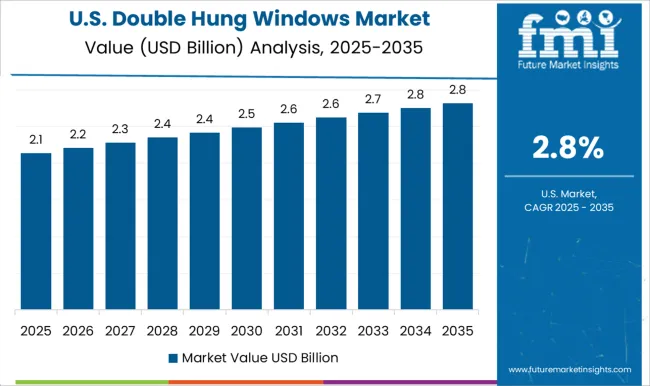
The double hung windows market in the USA is projected to grow at a CAGR of 2.8%. Growth remains moderate due to the mature market, though demand persists in residential renovations and replacement projects. Homeowners increasingly seek energy-efficient and aesthetically appealing window solutions, which drive steady adoption. The presence of strict energy codes and growing consumer awareness of long-term energy savings also supports market stability, ensuring continued demand for high-quality double hung windows across residential and commercial applications.
The double hung windows market is defined by strong competition among leading brands such as JELD-WEN, Andersen, and Pella, each holding a significant position due to their longstanding reputation and ability to deliver quality products. JELD-WEN emphasizes a broad product line with a balance between affordability and performance, allowing the brand to remain competitive across residential and commercial construction projects. Andersen is widely recognized for premium double hung windows that combine aesthetics with energy efficiency, creating strong demand among homeowners seeking both design flexibility and durability.
Pella maintains its strength in the market with a focus on innovative design options and strong dealer networks, enabling wide accessibility for customers. Collectively, these three companies define much of the competitive narrative through their brand recognition, distribution capabilities, and consistent investments in expanding product offerings. The competitive landscape is further shaped by Marvin, PGT, and a diverse set of regional players, each influencing the market with niche strengths. Marvin is well-regarded for premium customization, making its double hung windows attractive to consumers looking for tailored solutions with an emphasis on craftsmanship.
PGT has positioned itself strongly in regions prone to extreme weather, supplying impact-resistant and durable double hung windows that meet strict building codes. Smaller and regional players, grouped under the “others” category, add competitive pressure by offering cost-effective solutions and faster delivery to local markets.
| Item | Value |
|---|---|
| Quantitative Units | USD 5.5 Billion |
| Type | Traditional double-hung window and Tilt-in double-hung window |
| Window Material | Vinyl, Wood, Fiberglass, and Others |
| Frame Material | UPVC, Glass, Aluminium, and Others |
| Application | Residential, Commercial, and Industrial |
| End Use | Renovation and replacement and New construction |
| Distribution Channel | Indirect and Direct |
| Regions Covered | North America, Europe, Asia-Pacific, Latin America, Middle East & Africa |
| Country Covered | United States, Canada, Germany, France, United Kingdom, China, Japan, India, Brazil, South Africa |
| Key Companies Profiled | JELD-WEN, Andersen, Pella, Marvin, PGT, and Others |
| Additional Attributes | Dollar sales by window type (single-hung, double-hung, casement), Dollar sales by frame material (vinyl, wood, aluminum, composite), Trends in energy-efficient glazing and thermal insulation, Growth in replacement and remodeling activities, Adoption of smart and automated window systems, Regional patterns of double-hung window installation across residential and commercial projects. |
The global double hung windows market is estimated to be valued at USD 5.5 billion in 2025.
The market size for the double hung windows market is projected to reach USD 7.6 billion by 2035.
The double hung windows market is expected to grow at a 3.3% CAGR between 2025 and 2035.
The key product types in double hung windows market are traditional double-hung window and tilt-in double-hung window.
In terms of window material, vinyl segment to command 52.0% share in the double hung windows market in 2025.






Full Research Suite comprises of:
Market outlook & trends analysis
Interviews & case studies
Strategic recommendations
Vendor profiles & capabilities analysis
5-year forecasts
8 regions and 60+ country-level data splits
Market segment data splits
12 months of continuous data updates
DELIVERED AS:
PDF EXCEL ONLINE
Double Zipper Bags Market Size and Share Forecast Outlook 2025 to 2035
Double End Truck Wrench Market Size and Share Forecast Outlook 2025 to 2035
Double Coated Film Tapes Market Size and Share Forecast Outlook 2025 to 2035
Double Stack Oven Market Size and Share Forecast Outlook 2025 to 2035
Double Decker Roll Forming Machine Market Size and Share Forecast Outlook 2025 to 2035
Double Sided Tapes Market Size, Share & Forecast 2025 to 2035
Competitive Overview of Double Decker Roll Forming Machine Market Share
Double Seam Bowl Market
High Power Double-Clad Fiber Bragg Grating Market Size and Share Forecast Outlook 2025 to 2035
Aircraft Windows and Windshields Market Size and Share Forecast Outlook 2025 to 2035
Energy Efficient Windows Market Size and Share Forecast Outlook 2025 to 2035
Commercial Energy-Efficient Windows Market Size and Share Forecast Outlook 2025 to 2035
Residential Energy Efficient Windows Market Size and Share Forecast Outlook 2025 to 2035

Thank you!
You will receive an email from our Business Development Manager. Please be sure to check your SPAM/JUNK folder too.
Chat With
MaRIA